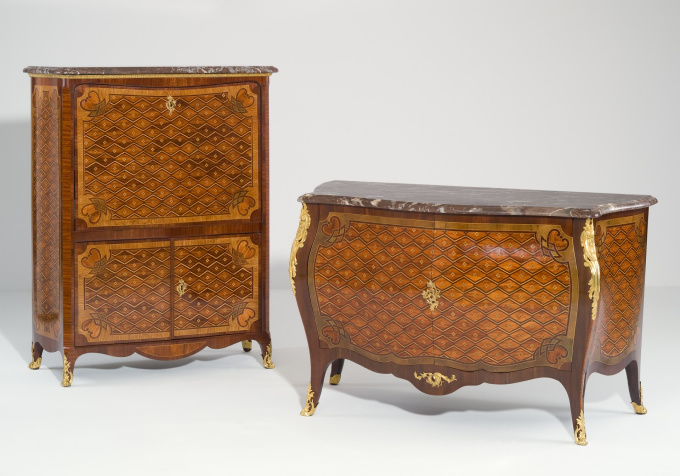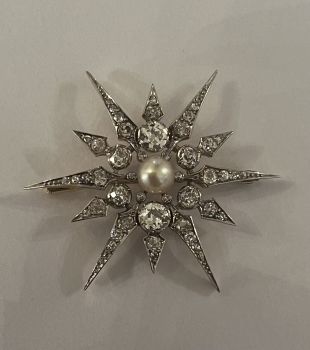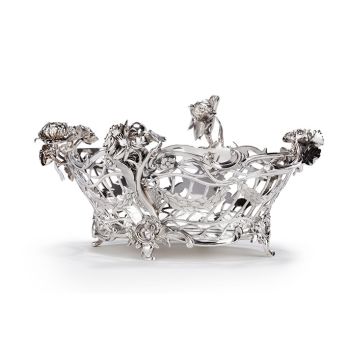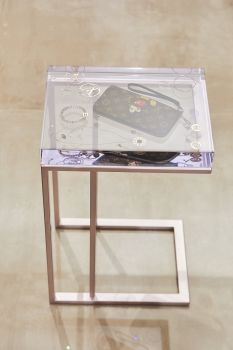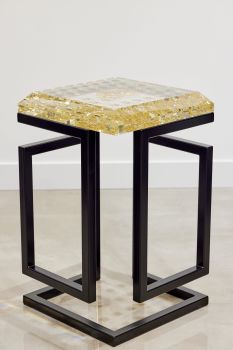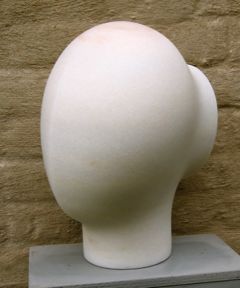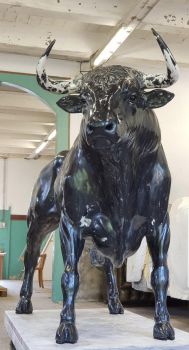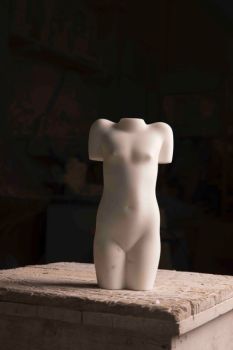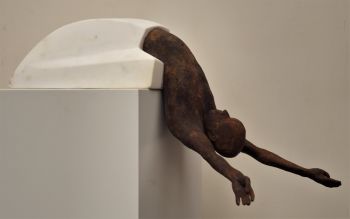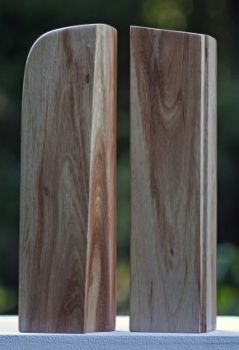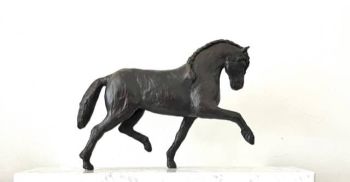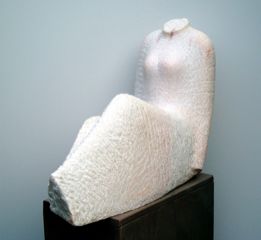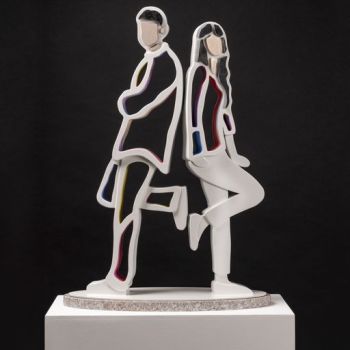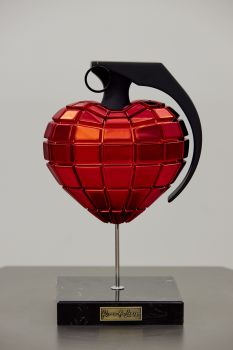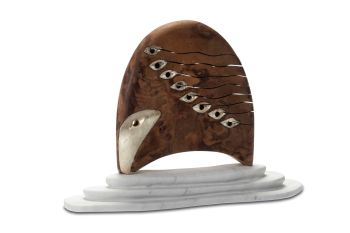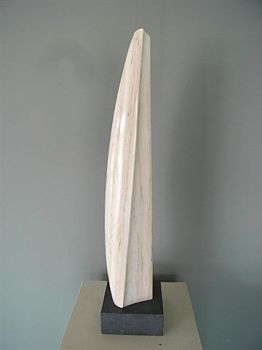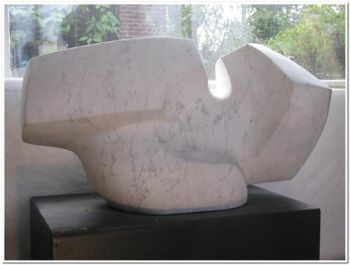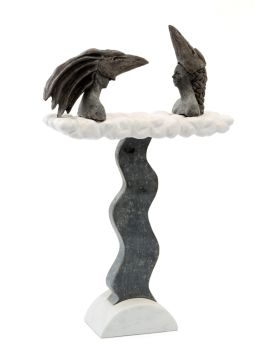A Matched Ensemble of Secrétaire and Commode 1760 - 1770
Artista Desconocido
MármolPiedraMaderarobleMármol rojo
89 ⨯ 144 ⨯ 66 cm
Actualmente no disponible a través de Gallerease
- Sobre la obra de arteCommode
The commode has an interior with one shelf. The front and side are bulged out. The front is fitted with to doors instead of drawers. The doors are fitted with a bronze ornamented scutcheon in the middle. The curved corners are mounted with gilt bronze mounts that are decorated with acanthus and flowers. The mounting on the skirt and the scutcheon are decorated with asymmetrical rocailles and flowers.
Front and sides of the commode are decorated with a geometrical inlayed zig-zag pattern that is studded with small rosette-motives. The geometrical pattern is framed in a cartouche.
Measurements: heigth 89 cm, width 144 cm, depth 66 cm.
Secrétaire
The lower part of the secrétaire is a cupboard with a shelf that is closed by two doors. The upper part is closed by a leaf that once extended serves as a writing desk. The writing desk is lined with green leather. The interior is veneered with mahogany, boxwood and kingwood. The interior has seven drawers, an open section and a curved shelf. The exterior is decorated on the side and the front with a geometrical inlayed zig-zag pattern that is studded with small rosette-motives. The zigzag pattern is framed in cartouches with ornamented corners.
Ensembles of different types of furniture with a similar decoration were often seen in the 18th century as a means to enhance the unity of an interior. In the Netherlands this practice was copied from the French, who were very strong on the unity and harmony of colours and materials in the interior design.
An identical commode is to be found in the collection of the Markiezenhof in Bergen op Zoom. Undoubtedly these commodes were once eachother’s pendants that might have been seperated when the pieces were auctioned after the owners decease.
Measurements: height 137 cm, width 109 cm, depth 46 cm. - Sobre el artista
Puede suceder que un artista o creador sea desconocido.
Algunas obras no deben determinarse por quién está hecho o por (un grupo de) artesanos. Algunos ejemplos son estatuas de la Antigüedad, muebles, espejos o firmas que no son claras o legibles, pero también algunas obras no están firmadas en absoluto.
También puedes encontrar la siguiente descripción:
•"Atribuido a …." En su opinión, probablemente una obra del artista, al menos en parte.
•“Estudio de….” o “Taller de” En su opinión, una obra ejecutada en el estudio o taller del artista, posiblemente bajo su supervisión
•“Círculo de…” En su opinión, una obra del período del artista que muestra su influencia, estrechamente asociado con el artista pero no necesariamente su alumno.
•"Estilo de …." o “Seguidor de…”. En su opinión, una obra ejecutada al estilo del artista pero no necesariamente por un alumno; puede ser contemporáneo o casi contemporáneo
•"Manera de …." En su opinión una obra al estilo del artista pero de fecha posterior
•"Después …." En su opinión, una copia (de cualquier fecha) de una obra del artista
•“Firmado…”, “Fechado…” o “Inscrito” En su opinión, la obra ha sido firmada/fechada/inscrita por el artista. La adición de un signo de interrogación indica un elemento de duda.
•“Con firma…”, “Con fecha…”, “Con inscripción…” o “Lleva firma/fecha/inscripción” en su opinión la firma/fecha/inscripción ha sido añadida por alguien que no es el artista
Artwork details
Related artworks
- 1 - 4 / 12
Artista Desconocido
A Surinam-themed Amsterdam long-case clock1746 - 1756
Precio a consultarZebregs & Röell - Fine Art - Antiques
 curada por
curada porGallerease Magazine
1 - 4 / 17Artista Desconocido
UNA COLECCIÓN DE CUATRO CAJAS BÍBLICAS DE MARFIL DE SRI LANKAN18th century
Precio a consultarZebregs & Röell - Fine Art - Antiques
Artista Desconocido
The Stamford Raffles Secretaires.1800 - 1813
Precio a consultarZebregs & Röell - Fine Art - Antiques
1 - 4 / 24- 1 - 4 / 24

